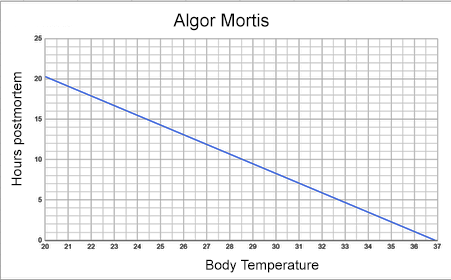
Determining the time of death (TOD) is a critical aspect of forensic investigation, and it involves considering various factors and using multiple methods rather than relying solely on one formula. Students in anatomy classes may be interested in the study of forensics, or the scientific analysis of physical evidence from a crime scene. This may include gathering evidence to determine the time of death.
Student Activity: Forensic Investigation – Calculating Time of Death
For students interested in this topic, I recommend the book: Stiff, by Mary Roach or Past Mortems by Carla Valentine
Forensic Analysis
Here are some approaches commonly used in forensic science to estimate the time of death:
- Rigor Mortis: This refers to the stiffening of muscles after death. It begins within a few hours of death, peaks around 12 hours, and then gradually diminishes. By assessing the degree of rigor mortis in different muscle groups, forensic experts can estimate the time since death.
- Lividity: Livor mortis is the settling of blood in the lowest parts of the body after death, causing discoloration. The pattern of lividity can provide clues about the position of the body after death and can help estimate the time elapsed since death.
- Body Temperature: The body cools down to ambient temperature after death. Measuring the body’s temperature and considering ambient conditions can help estimate the time of death. (Glaister Equation)
- Decomposition: The process of decay can provide information about the time since death. Different stages of decomposition, such as bloating, putrefaction, and skeletonization, occur over specific time frames and can be used to estimate the time of death.
- Insect Activity: Forensic entomology involves studying the insects present on or around the body. By examining the type of insects, their life cycles, and stages of development, entomologists can estimate time of death.
- Chemical Changes: Chemical changes in the body, such as potassium levels in the vitreous humor of the eye or changes in the composition of bodily fluids, can also be used to estimate the time since death.
Simplified Version
- If the body feels warm and no rigor is present, death occurred under 3 hours before.
- If the body feels warm and stiff, death occurred 3-8 hours earlier.
- If the body feels cold and stiff, death occurred 8-36 hours earlier.
- If the body is cold and not stiff, death occurred more than 36 hours earlier.
The Glaister Equation
This equation is used to calculate time of death. Temperature (x) is in Celsius.
(36.9-x) * 6/5
Example
The temperature of the body is 32 degrees Celsius.
(36.9 -32) x 6/5
4.9 x 1.2 = 5.88
The body has been dead for 5.88 hours. Approximately 6 hours
The Glaister Equation Graph

Other Resources Related to Forensics
Article: Body Farm with Analysis Questions

